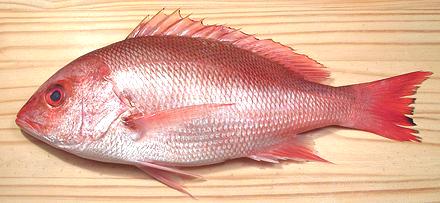 [family Lutjanidae (Snappers)]
[family Lutjanidae (Snappers)]
Snappers, particularly the Pacific and Northern Red Snapper, are very highly regarded as food fish and demand a premium price. For this reason, various other fish, many not even in the Snapper family, are marketed as "Snapper" and even as "Red Snapper". If you buy "Red Snapper" as fillets, there's no telling what you're getting, and in fancy restaurants you're even less likely to get the real thing - "substitution" is rampant.
More on Varieties of Fish
(very large page).

Often marketed as "Snapper from New Zealand", this fish is not really
a Snapper at all, but a Porgy - see
Silver Seabream.
 [Lutjanus peru]
[Lutjanus peru]
This true Red Snapper is found from Mexico to Peru in the Eastern
Pacific. It can get up to 37 inches long and up to almost 13 pounds but
the photo specimen was 15-1/4 inches and weighed 1 pound 14 ounces, a bit
larger than average market size. This snapper is a premium fish and fetches
a premium price. Pacific Red Snapper is IUCN rated NE (Not Evaluated)
and is not considered threatened.
Details and Cooking.
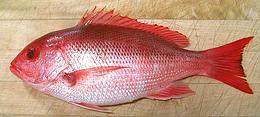 [Lutjanus vivanus]
[Lutjanus vivanus]
This Snapper is found along the coast of the Western Atlantic, from
North Carolina to São Paulo, Brazil, but is most common around
the Antilles and Bahamas. It can get up to almost 33 inches long and
18 pounds but the photo specimen was 12-3/4 inches and weighed 1
pound 1-7/8 ounces. It looks almost identical to the Pacific Red
Snapper but its cooking properties are a little different. There have
been reports of ciguatera poisoning
from eating this fish from tropical reef environments. Silk Snapper
is Red List rated NE (Not Evaluated) but is not considered threatened.
Details and Cooking.
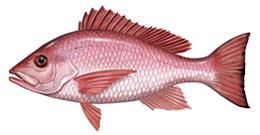 [Lutjanus campechanus]
[Lutjanus campechanus]
This popular fish is found in the Gulf of Mexico and off the Western
Atlantic coast to Massachusetts but is rare above North Carolina. It can
grow to 39 inches and 48 pounds. There have been reports of
ciguatera poisoning from eating this fish
from tropical reef environments. The body of this fish is deeper than
the Pacific Red Snapper and the face more tapered to a point. This fish
was badly over-fished, but the fishery is now better managed and
populations have been recovering. We presume the culinary characteristics
of this fish are very similar to its close relative, the Pacific Red
Snapper, so refer to Details and
Cooking for that fish. Drawing by U.S. Federal
Government (NOAA Fishwatch) = public domain.
 [Ocyurus chrysurus]
[Ocyurus chrysurus]
This true Snapper is found from Massachusetts (rarely) through the
Caribbean and along the northeastern coast of South America as far
south as northern Brazil. It can get up to nearly 34 inches long
and 9 pounds, but is commonly around 16 inches. The photo specimen was
16 inches and weighed 1 pound 6-3/4 ounces. This snapper is a premium
fish and fetches a premium price. Yellowtail Snapper is not considered
threatened, IUCN Red List rated NE (Not Evaluated). Some fish
are now being farmed. There have been reports of ciguatera poisoning
from fish caught in a tropical reef environment.
Details and Cooking.
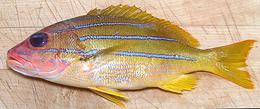 [Lutjanus kasmira]
[Lutjanus kasmira]
This true Snapper is native to the Indo-Pacific region, from the east
coast of Africa to Hawaii. It can get up to nearly almost 16 inches
long and 9 pounds, but is commonly around 10 inches. The photo
specimen was 10 inches long and weighed 8-1/4 ounces. This snapper is
a premium fish and fetches a premium price, but not as high as some
other snappers. Bluestripe Snapper is not considered threatened,
IUCN Red List rated NE (Not Evaluated).
Details and Cooking.
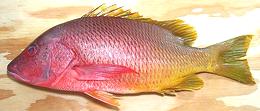 [Yellow Pargo (Sports fishing); Pargo amarillo, Huachinango (Spanish);
Lutjanus argentiventris]
[Yellow Pargo (Sports fishing); Pargo amarillo, Huachinango (Spanish);
Lutjanus argentiventris]
This true Snapper is found in the Eastern Pacific, from Southern
California (just a little above the Mexican border), south to Peru.
It can grow to 28 inches and 28 pounds, but the photo specimen was
18-1/2 inches and weighed 3 pound 8-3/4 ounces. Yellow Snapper is
IUCN Red List rated LC (Least Concern). Aquaculture is in
experimental stages.
Details and Cooking.
 [Lutjanus peru]
[Lutjanus peru]
This true Snapper is found in the Gulf of Mexico, Caribbean and
West Atlantic from North Carolina to southern Brazil. It can grow to 24
and nearly 8 pounds but is commonly around 10 inches. The photo specimen
was 13 inches and weighed 14-5/8 ounces. This snapper is less well known
than the Pacific Red Snapper so sells at a significantly lower price
(in this case US $3.99 vs $6.49). There have been some reports of
ciguatera poisoning from eating this
fish caught in tropical reef environments. This fish.is IUCN rated NE
(Not Evaluated) and is not considered threatened.
Details and Cooking.
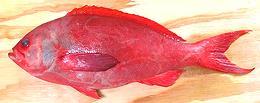 [Pristipomoides macrophthalmus?]
[Pristipomoides macrophthalmus?]
This true Snapper is found all around the Caribbean, from Yucatan
along the north coast of South America, off the tip of Florida
and along the Caribbean island chain. It can get up to 20 inches
long, but the photo specimen was 15-3/4 inches long and weighed 1
pound 15-1/4 ounces, a bit larger than average market size. This
snapper is an excellent eating fish, but at my local Philippine fish
market it was selling at 2013 US $2.99/pound, while the better known
"True Red Snapper" was selling at $6.99/pound. Cardinal Snapper is
IUCN rated NE (Not Evaluated) and is not considered threatened.
Details and Cooking.
 [Lutjanus purpureus]
[Lutjanus purpureus]
This snapper is native to the Caribbean to as far south as northern
Brazil but doesn't extend north into the Gulf of Mexico. It can grow to
about 39 inches 22 pounds. In appearance it is similar to the Northern
Red Snapper but has an oval darker spot on the lateral line near the
tail, which may fade in maturity. There have been reports of
ciguatera poisoning from eating this
fish from tropical reef environments Not considered threatened.
Photo from PLOS distributed under license
Creative Commons
Attribution-ShareAlike v2.5 Generic.
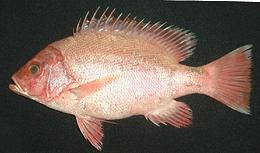 [Cá hong do (Viet); Lutjanus erythropterus]
[Cá hong do (Viet); Lutjanus erythropterus]
This is what an Australian would probably have in mind as a Red Snapper.
This species inhabits the Indo-Pacific region and is particularly
common on the northern coast of Australia and in Indonesian waters,
though it extends as far north as southern Japan. It is both caught
wild and farmed. It can grow to 32 inches long but is commonly around
17 inches, and farmed fish will be smaller. Not considered threatened.
Photo by Hamid Badar Osmany distributed under license
equivalent to Creative Commons
Attribution-ShareAlike v3.0 Unported Attribution Required.
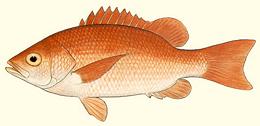 [Lutjanus jordani]
[Lutjanus jordani]
This fish is native from the southern tip of Baja, Mexico down
the coast to Peru and the Galapagos Islands. The grow to 23 inches and
are commercially fished. Not considered threatened, Red List
status LC (Least Concern).
Illustration by G.R.Allen from FAO Species Catalog Vol.6
distributed under license
Attribution-NonCommercial v3.0 Unported
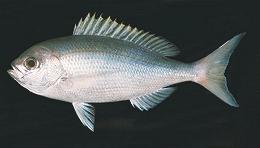 [Blue Snapper, Blue Fusilier; Aodai (Japan); Paracaesio caerulea]
[Blue Snapper, Blue Fusilier; Aodai (Japan); Paracaesio caerulea]
This fish is a commercial catch, found mostly around southern Japan,
but recently reported from Taiwan and New Caladonia. It can grow to 20
inches, but is commonly 12 inches long. It is a fairly fatty fis, used
as sushi in Japan. IUCN rated DD (Data Deficient) 2009.
Photo by J.E.Randall distributed under license
Attribution-NonCommercial v3.0 Unported